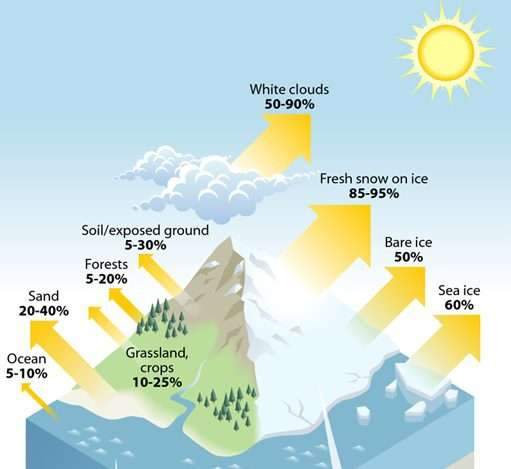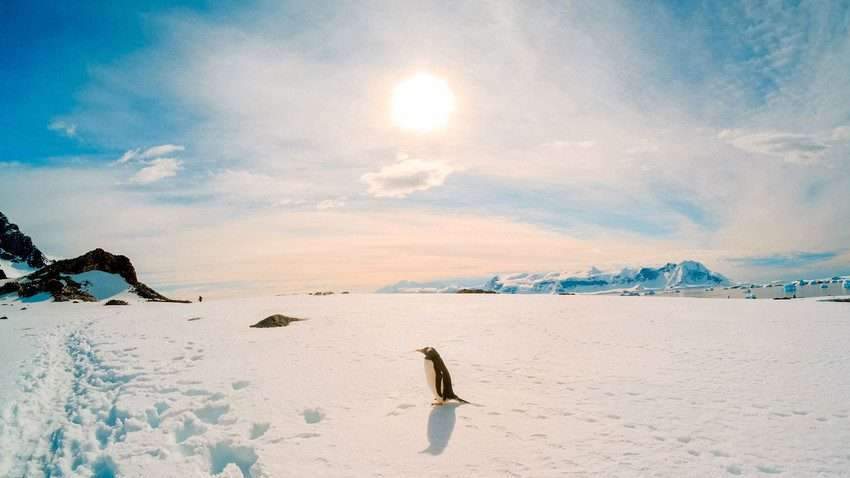Snow cover helps regulate the Earth’s surface temperature,
so seasonal snow is an important part of the Earth’s climate system.
When this snow melts, it contributes mainly to filling rivers and water reservoirs in many parts of the world.
The snow cover is also the largest component of the cryosphere in terms of area,
covering about 46 million km2 of the Earth’s surface each year.
While about 98% of the Earth’s ice cover is located in the Northern Hemisphere,
it also contributes to maintaining the Earth’s heat balance.
This is through some of its unique properties such as reflection and isolation.

Reflectance
The white snow cover reflects about 80-90% of the sun’s energy to the atmosphere,
as the white snow has a high reflectivity of sunlight.
While trees, plants and soil reflect only 10-30% of the sunlight,
an effect that appears more during the spring.
When the days become longer and the amount of sunlight increases over the snow-covered areas,
then the high reflectivity of the snow helps cool the planet, which contributes to maintaining the Earth’s temperature balance.

Insulation
Snow cover also contributes to keeping the Earth warm, in addition to its role in cooling the Earth.
Where the snow cover acts as an insulating blanket;
To preserve the heat of the earth beneath it,
as a layer of snow with a thickness of 30 cm is sufficient to protect the soil and living organisms from the decrease in the air temperature above the surface of the snow.
Snow also helps retain heat and prevent moisture from evaporating into the atmosphere,
as the cold, wet surface of snow affects the amount of heat and moisture exchanged between the Earth and the atmosphere.
Snow cover on other materials, such as permafrost, river ice or sea ice,
prevents the ice from spreading underneath.
Also, when the soil freezes, it traps gases such as carbon and methane,
which prevents them from being released into the air and atmosphere.
Carbon and methane are greenhouse gases that cause global warming,
another benefit of snow cover on soil.
Frozen soil also prevents the movement of water within the soil and on the soil surface,
because the surface of the soil is frozen, it absorbs less liquid water that would increase runoff.

The impact of climate change on buildings and constructions
Wetted winters and sudden heavy rains make it more important to direct rainwater and meltwater away from homes, pavements, roads, etc.
A mild climate will reduce the durability of building materials and affect the indoor climate of buildings,
and warmer summers will increase the need for cooling.
High groundwater levels, rising water levels in streams and watercourses,
and increased storm surge risks along the coast make it relevant to protecting buildings from infiltration and flooding.

Buildings
Buildings can be vulnerable to climate change and, in the future,
there may be increased risks of collapse and poor health.
And significant loss in value as a result of further storm, snow or landing damage,
water creep, indoor climate deterioration and reduced building life.
In the short term, strong storms are the biggest challenge.
Storms will present a safety hazard in those parts of existing buildings that do not meet the safety requirements of the building code.
In the long term, prolonged heat waves can have health consequences,
especially for the elderly and the vulnerable, in nursing homes, for example.
Adapting buildings to climate change
With regard to the reinforcement of existing buildings,
independent adaptation will be limited if the owners are not aware of the weaknesses in the bearing elements of their buildings.
Adaptation will only occur in new construction if standards are improved,
and to counteract the consequences of heat waves, the installation of air conditioners in existing buildings can be expected,
along with the demand for buildings with more efficient indoor climate control.
To counter heat waves, new regulations on the building code’s Energy Framework represent a step towards enhancing solar screening and heat insulating windows,
which will facilitate indoor climate regulation.
Currently, there are no recommended measures for building expansion or renovation.
In the future, there may be a need to inform existing building owners of typical weaknesses in the load-bearing elements,
with corresponding instructions on how to remedy them.
In the same way, guidance may be needed on new building solutions to reduce extreme indoor temperatures during heat waves, especially for buildings at risk.
Finally, there may be a need to inform building technicians of recommended future-oriented design criteria,
for example, regarding maximum snow load, wind speeds, temperatures and periods of future heat waves,
and maximum precipitation intensity that the building must withstand.
For more architectural news








